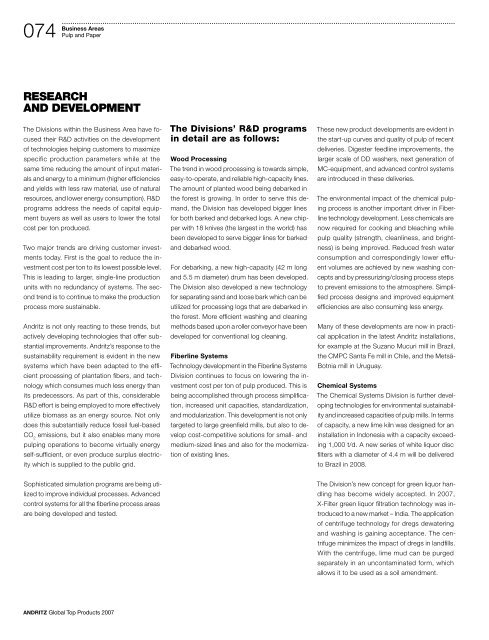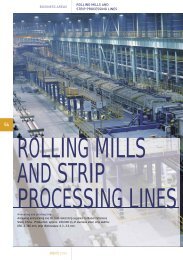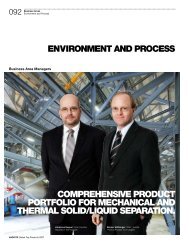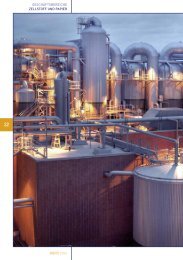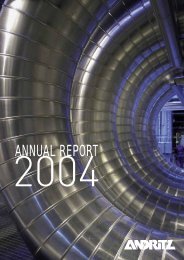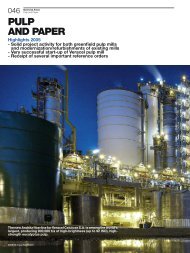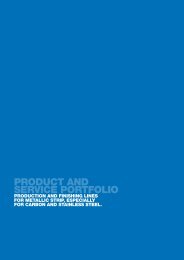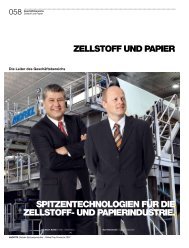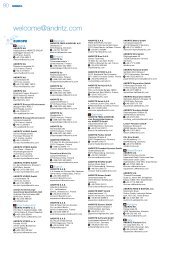Download as pdf - andritz business areas
Download as pdf - andritz business areas
Download as pdf - andritz business areas
- No tags were found...
You also want an ePaper? Increase the reach of your titles
YUMPU automatically turns print PDFs into web optimized ePapers that Google loves.
074<br />
Business Are<strong>as</strong><br />
Pulp and Paper<br />
Research<br />
and Development<br />
The Divisions within the Business Area have focused<br />
their R&D activities on the development<br />
of technologies helping customers to maximize<br />
specific production parameters while at the<br />
same time reducing the amount of input materials<br />
and energy to a minimum (higher efficiencies<br />
and yields with less raw material, use of natural<br />
resources, and lower energy consumption). R&D<br />
programs address the needs of capital equipment<br />
buyers <strong>as</strong> well <strong>as</strong> users to lower the total<br />
cost per ton produced.<br />
Two major trends are driving customer investments<br />
today. First is the goal to reduce the investment<br />
cost per ton to its lowest possible level.<br />
This is leading to larger, single-line production<br />
units with no redundancy of systems. The second<br />
trend is to continue to make the production<br />
process more sustainable.<br />
Andritz is not only reacting to these trends, but<br />
actively developing technologies that offer substantial<br />
improvements. Andritz’s response to the<br />
sustainability requirement is evident in the new<br />
systems which have been adapted to the efficient<br />
processing of plantation fibers, and technology<br />
which consumes much less energy than<br />
its predecessors. As part of this, considerable<br />
R&D effort is being employed to more effectively<br />
utilize biom<strong>as</strong>s <strong>as</strong> an energy source. Not only<br />
does this substantially reduce fossil fuel-b<strong>as</strong>ed<br />
CO 2<br />
emissions, but it also enables many more<br />
pulping operations to become virtually energy<br />
self-sufficient, or even produce surplus electricity<br />
which is supplied to the public grid.<br />
The Divisions’ R&D programs<br />
in detail are <strong>as</strong> follows:<br />
Wood Processing<br />
The trend in wood processing is towards simple,<br />
e<strong>as</strong>y-to-operate, and reliable high-capacity lines.<br />
The amount of planted wood being debarked in<br />
the forest is growing. In order to serve this demand,<br />
the Division h<strong>as</strong> developed bigger lines<br />
for both barked and debarked logs. A new chipper<br />
with 18 knives (the largest in the world) h<strong>as</strong><br />
been developed to serve bigger lines for barked<br />
and debarked wood.<br />
For debarking, a new high-capacity (42 m long<br />
and 5.5 m diameter) drum h<strong>as</strong> been developed.<br />
The Division also developed a new technology<br />
for separating sand and loose bark which can be<br />
utilized for processing logs that are debarked in<br />
the forest. More efficient w<strong>as</strong>hing and cleaning<br />
methods b<strong>as</strong>ed upon a roller conveyor have been<br />
developed for conventional log cleaning.<br />
Fiberline Systems<br />
Technology development in the Fiberline Systems<br />
Division continues to focus on lowering the investment<br />
cost per ton of pulp produced. This is<br />
being accomplished through process simplification,<br />
incre<strong>as</strong>ed unit capacities, standardization,<br />
and modularization. This development is not only<br />
targeted to large greenfield mills, but also to develop<br />
cost-competitive solutions for small- and<br />
medium-sized lines and also for the modernization<br />
of existing lines.<br />
These new product developments are evident in<br />
the start-up curves and quality of pulp of recent<br />
deliveries. Digester feedline improvements, the<br />
larger scale of DD w<strong>as</strong>hers, next generation of<br />
MC-equipment, and advanced control systems<br />
are introduced in these deliveries.<br />
The environmental impact of the chemical pulping<br />
process is another important driver in Fiberline<br />
technology development. Less chemicals are<br />
now required for cooking and bleaching while<br />
pulp quality (strength, cleanliness, and brightness)<br />
is being improved. Reduced fresh water<br />
consumption and correspondingly lower effluent<br />
volumes are achieved by new w<strong>as</strong>hing concepts<br />
and by pressurizing/closing process steps<br />
to prevent emissions to the atmosphere. Simplified<br />
process designs and improved equipment<br />
efficiencies are also consuming less energy.<br />
Many of these developments are now in practical<br />
application in the latest Andritz installations,<br />
for example at the Suzano Mucuri mill in Brazil,<br />
the CMPC Santa Fe mill in Chile, and the Metsä-<br />
Botnia mill in Uruguay.<br />
Chemical Systems<br />
The Chemical Systems Division is further developing<br />
technologies for environmental sustainability<br />
and incre<strong>as</strong>ed capacities of pulp mills. In terms<br />
of capacity, a new lime kiln w<strong>as</strong> designed for an<br />
installation in Indonesia with a capacity exceeding<br />
1,000 t/d. A new series of white liquor disc<br />
filters with a diameter of 4.4 m will be delivered<br />
to Brazil in 2008.<br />
Sophisticated simulation programs are being utilized<br />
to improve individual processes. Advanced<br />
control systems for all the fiberline process are<strong>as</strong><br />
are being developed and tested.<br />
The Division’s new concept for green liquor handling<br />
h<strong>as</strong> become widely accepted. In 2007,<br />
X-Filter green liquor filtration technology w<strong>as</strong> introduced<br />
to a new market – India. The application<br />
of centrifuge technology for dregs dewatering<br />
and w<strong>as</strong>hing is gaining acceptance. The centrifuge<br />
minimizes the impact of dregs in landfills.<br />
With the centrifuge, lime mud can be purged<br />
separately in an uncontaminated form, which<br />
allows it to be used <strong>as</strong> a soil amendment.<br />
ANDRITZ Global Top Products 2007


